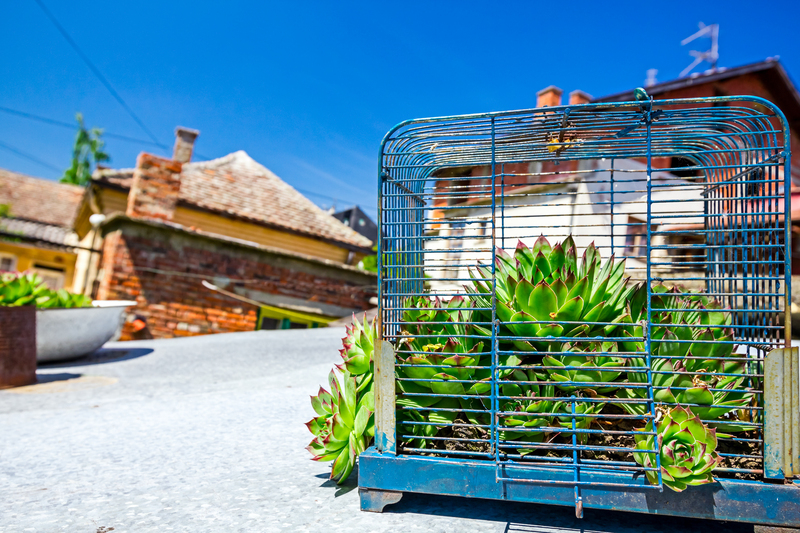Get Started on Your Neglected Garden's Journey to Beauty
Posted on 28/05/2025
Get Started on Your Neglected Garden's Journey to Beauty
Have you ever looked out at your backyard or front garden and felt overwhelmed by wild growth, stubborn weeds, or sad, wilting plants? If so, you're not alone. Many homeowners have a neglected garden at some stage. Perhaps life got busy or inspiration waned. The good news? Reviving a neglected garden is entirely possible--and immensely rewarding! Let's explore a step-by-step guide to transform your garden from forlorn to fabulous.

Why Beautify Your Neglected Garden?
There are countless reasons to start your garden transformation journey:
- Increase property value: A healthy, attractive garden can add thousands to your home's resale value.
- Boost mental well-being: Spending time outdoors and connecting with nature has proven benefits for mental health.
- Create a biodiversity haven: Even small gardens can become refuges for pollinators, birds, and beneficial insects.
- Outdoor entertaining & relaxation: Beautiful gardens provide idyllic settings for gatherings or solo downtime.
Ready to begin? Roll up your sleeves, clear some time in your schedule, and let's get started on your neglected garden's journey to beauty!
Step 1: Assess Your Outdoor Space
Before you can effect a meaningful change, evaluate your starting point.
Walkthrough & Observation
- Take notes and photos--Capture images of trouble spots and jot down initial ideas or concerns.
- Look for shade, sunlight, and soil type--Which areas get the most/least sun? Is it dry, damp, sandy, or clay-rich?
- Identify existing plants and weeds--Some may be salvageable, while others will need to go.
Set Realistic Goals
- Are you aiming for a low-maintenance haven? A family-friendly play space? A wildlife-friendly retreat?
- Sketch simple plans or inspiration boards for your neglected garden makeover.
Step 2: Clear the Clutter
Decluttering is the foundation of any successful garden makeover.
Remove Debris and Junk
- Pick up sticks, stones, litter, and any broken garden furniture.
- Dispose of dead plants and cut back unsalvageable shrubs or tree branches.
- If you have old compost heaps or garden waste piles, refresh or remove them.
Weed Like a Pro
- Pull weeds by the root, especially invasive types.
- For large areas, consider using a pointed hoe or mattock.
- Layer cardboard/newspaper and mulch in persistent weed patches.
Tip: Keep tools sharp and ergonomic to make the job easier and prevent fatigue.
Step 3: Revive the Soil
Great gardens start with great soil. After years of neglect, your garden bed might be compacted, dry, or nutrient-poor. Here's how to bring it back to life:
- Test the soil using a basic kit (available at garden centers or online).
- Loosen the soil with a fork or cultivator to allow air, water, and roots to penetrate.
- Add organic matter: compost, leaf mulch, or well-rotted manure boost fertility and structure.
- Check drainage--if water pools, consider raising beds or digging in grit.
Healthy soil = healthy plants and a successful garden transformation!
Step 4: Retain and Revitalize Existing Plants
Before you clear away everything, see what can be saved. Sometimes, perennial plants, shrubs, and even trees simply need a prune or a feed to feel rejuvenated.
- Prune back dead, damaged, or crowded growth--Use clean, sharp shears.
- Feed--Apply slow-release fertilizer or seaweed solution to tired plants for a nutritional boost.
- Transplant--If plants are too close together, gently move healthy ones to more suitable spots.
- Water--A deep, thorough soak can revive the most wilted greenery.
Remember: Mature plants save time and money and offer instant structure to your neglected garden restoration.
Step 5: Plan Your Garden Makeover
Prioritize Projects
- Decide what needs tackling first--usually, this means structural or hard landscaping jobs: repairing paths, fixing fences, or leveling borders.
- Start with high-impact changes, such as planting colorful new borders or creating a lawn area.
Select New Plants
- Focus on low-maintenance, resilient varieties if you're short on time.
- Mix evergreen shrubs for year-round structure with seasonal perennials and annual bedding for pops of color.
- Choose native plants to attract local wildlife and suit your climate.
- Don't forget bulbs for spring drama and late-summer blooms to extend the season's beauty.
Pro Tip: Group plants in odd numbers and repeat similar shapes or colors for a designer look.
Step 6: Tackle the Hard Landscaping
Transforming your overgrown yard isn't just about planting--it's about creating harmonious spaces. Consider these elements:
- Paths: Gravel, stepping stones, or bark mulch define walkways and add structure.
- Edging: Tidy edging separates beds from lawns and keeps mulch in place.
- Patios & seating areas: A simple bench or cafe set encourages you to use the space.
- Vertical interest: Arbors, pergolas, trellises, or screening create depth and privacy.
Plan your layout on paper before starting, and tackle one feature at a time to avoid feeling overwhelmed.
Step 7: Mulch and Maintain
Once your new and refreshed plants are in the ground, mulching is essential for ongoing neglected garden beauty:
- Suppress weeds--A 2-3 inch layer of bark, wood chips, or compost blocks weed seeds and conserves moisture.
- Regulate soil temperature--Mulch protects roots from heat and frost.
- Feeds the soil--As it breaks down, organic mulch improves soil health naturally.
Keep on top of watering during the first season, especially for new additions--consistent care leads to vibrant results.
Step 8: Finishing Touches for a Beautiful Garden
After the heavy lifting, it's time for the fun details that make your restored garden uniquely yours:
- Install solar or LED lights to enhance evening ambiance.
- Add containers, window boxes, or hanging baskets for instant color boosts.
- Hang or position bird feeders and baths to attract wildlife.
- Display statues, garden art, or decorative stones as personal focal points.
Celebrate your progress and enjoy the transformation!
Top Neglected Garden Restoration Tips
- Work with the seasons: Spring and fall are ideal for planting and major cleanups. Avoid heavy soil work in winter or during summer droughts.
- Enlist help: Rope in friends or family, or hire a local gardener for the initial heavy lifting.
- Be patient: Gardens take time to settle and mature. Small improvements each week will yield big results.
- Stay inspired: Follow gardening blogs or social media, visit open gardens, and keep up with the latest trends in landscape design.
Common Challenges and How to Overcome Them
1. Persistent Weeds
Solution: Consistency is key--remove weeds as soon as they appear and maintain thick mulch layers to smother regrowth.
2. Poor Soil Quality
Solution: Incorporate organic matter, use raised beds, and grow green manure crops like clover to improve fertility and structure over time.
3. Pests and Diseases
Identify issues early. Encourage beneficial insects, use physical barriers, and choose disease-resistant plant varieties wherever possible.
4. Overgrown Trees and Hedges
Seek professional help for safe pruning or removal. Well-maintained trees add structure and shade, but unchecked growth can outcompete other plants.
Garden Beauty Maintenance Plan
After the initial transformation, keeping your garden looking its best takes just a little regular effort:
- Weed weekly--Short sessions prevent backsliding.
- Prune before/after bloom--Check recommended times for your specific plants.
- Mulch annually--Top up beds every spring or autumn.
- Feed & water--Established gardens may only need feeding a few times a year; water deeply rather than frequently.
- Seasonal color--Add or swap in seasonal containers whenever you want a refresh.
Inspiring Ideas for Your Neglected Garden Makeover
- Wildlife corner: Leave a small log pile, plant wildflowers, or create a shallow pond for pollinators.
- Grow your own: Install a small vegetable plot, herb spiral, or a few fruit bushes for edible delights.
- Zen retreat: Add a water feature, gravel, and some shade-loving ferns for a calming nook.
- Outdoor living: Embrace outdoor rugs, shelters, and comfy seating to extend your usable space.

FAQ: Transforming a Neglected Garden
- How much time will it take?--Depends on size and condition, but set manageable mini-goals each week to prevent overwhelm.
- Do I need professional help?--Not necessarily, but complex landscaping, tree work, or pest infestations may require experts.
- What's the most cost-effective way to revive my garden?--Reuse and revive existing plants and materials wherever possible; propagate cuttings for free new plants.
- What if I have only a small space?--Many techniques work in pots or tiny yards--focus on a few statement plants and keep clutter to a minimum.
Embark on Your Garden's Journey to Beauty Today!
Your journey from a neglected garden to a vibrant, blooming paradise can begin right now. Remember, every great garden revival starts with a simple step--and with patience, passion, and a bit of elbow grease, the transformation will amaze you. Don't wait for the "perfect moment"; seize the day and nurture your garden's beauty for years to come.
Ready to get started? Share your progress, celebrate small victories, and let your outdoor space become a source of pride, tranquility, and joy!



